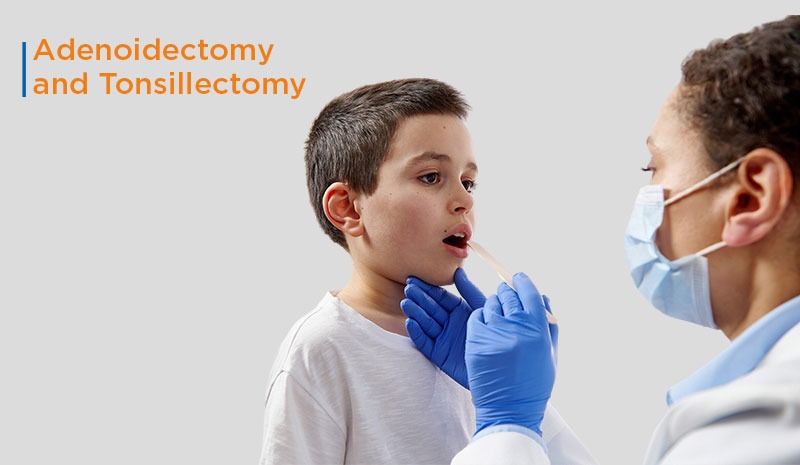Tonsillectomy vs Adenoidectomy: What Parents Need to Know

Introduction
Tonsils and adenoids play a crucial role in your child’s immune system. Positioned at the back of the throat and behind the nose, respectively, they work to trap germs. However, if these tissues become frequently infected or swollen, they can end up causing more problems than they solve.
In Ahmedabad, ENT specialists often encounter children facing issues such as:
- Mouth breathing
- Snoring or sleep apnea
- Recurrent sore throats
- Chronic ear infections
In these situations, doctors might suggest a tonsillectomy (removal of the tonsils), an adenoidectomy (removal of the adenoids), or even both.
Tonsillectomy
A tonsillectomy is a surgical procedure where the tonsils are removed. It’s one of the most common surgeries performed on children and is usually done under general anesthesia.
When is a Tonsillectomy Necessary?
Doctors specializing in ear, nose, and throat (ENT) may recommend this surgery if your child:
- Experiences 7 or more throat infections in a single year
- Has 5 or more infections for two consecutive years
- Suffers from sleep apnea or has trouble sleeping
- Struggles to swallow because of enlarged tonsils
How Is the Procedure Carried Out?
The surgery is relatively quick, typically lasting between 30 and 45 minutes. It can be performed using various techniques, including:
- Cold knife (the traditional method)
- Electrocautery
- Coblation (a minimally invasive technique that’s gaining popularity in India for quicker recovery)
After the surgery, recovery usually takes about 10 to 14 days, during which your child may need pain relievers and should stick to soft foods.
Adenoidectomy
An adenoidectomy is a procedure that removes the adenoids, which are situated behind the nose and can’t be seen from the mouth. When the adenoids enlarge, they can block the nasal passages, leading your child to breathe through their mouth or snore quite loudly.
Common Signs Your Child May Need One:
- Ongoing nasal congestion
- Trouble breathing through the nose
- Frequent ear infections
- Recurring sinus infections
- Daytime tiredness and irritability
In Ahmedabad, the seasonal dust and pollution often lead to an increase in adenoid-related cases during the winter and early summer months.
How Is It Done?
The surgery usually takes about 15 to 30 minutes and is often performed as a day-care procedure. The surgeon uses a small instrument that’s inserted through the mouth to take out the adenoids.
Recovery tends to be quicker than after a tonsillectomy, typically around 7 days.
Adenoidectomy and Tonsillectomy: When Are Both Needed?
In many situations, kids end up dealing with both enlarged tonsils and adenoids. When both of these are causing issues, ENT specialists usually suggest performing both surgeries at the same time.
Common Symptoms to Watch For:
- Snoring or pauses in breathing while sleeping
- Constant mouth breathing
- Frequent nasal and throat infections
- Trouble swallowing and speaking clearly
Why Combination Surgery Makes Sense:
- One trip to the hospital
- One round of anesthesia
- One recovery period
What to Expect: Before, During, and After Surgery
Before Surgery:
- Your ENT will ask for some basic tests, like blood work and a chest X-ray.
- You’ll need to fast for about 6 to 8 hours before the surgery.
- It’s also really important to prepare emotionally—try to explain the surgery in simple, reassuring terms.
During Surgery:
- They’ll use general anesthesia for the procedure.
- The whole thing usually takes between 30 to 60 minutes, depending on the procedures involved.
- Afterward, your child will be monitored in recovery for about 4 to 6 hours before they can head home.
After Surgery:
- You can expect a sore throat, a mild fever, and a bit of a reduced appetite.
- Stick to soft, cold foods like ice cream, khichdi, and yogurt for their diet.
- It’s best to avoid spicy, hot, or acidic foods during recovery.
- And don’t forget, staying hydrated is super important!
Risks, Side Effects & Recovery Tips
Common Side Effects:
- Mild bleeding from the mouth or nose
- Sore throat and ear pain (this can be referred pain)
- A temporary change in voice
Serious but Rare Risks:
- Heavy bleeding (occurs in less than 2% of cases)
- An infection that may need antibiotics
- Dehydration if your child isn’t drinking enough
Recovery Tips for Parents:
- Keep your child calm and make sure they stay hydrated
- Offer small meals throughout the day
- Stick to the follow-up schedule set by the doctor
- Use prescribed pain medications regularly for the first 2–3 days
- Avoid sending your child to school for 7–10 days to ensure proper healing
